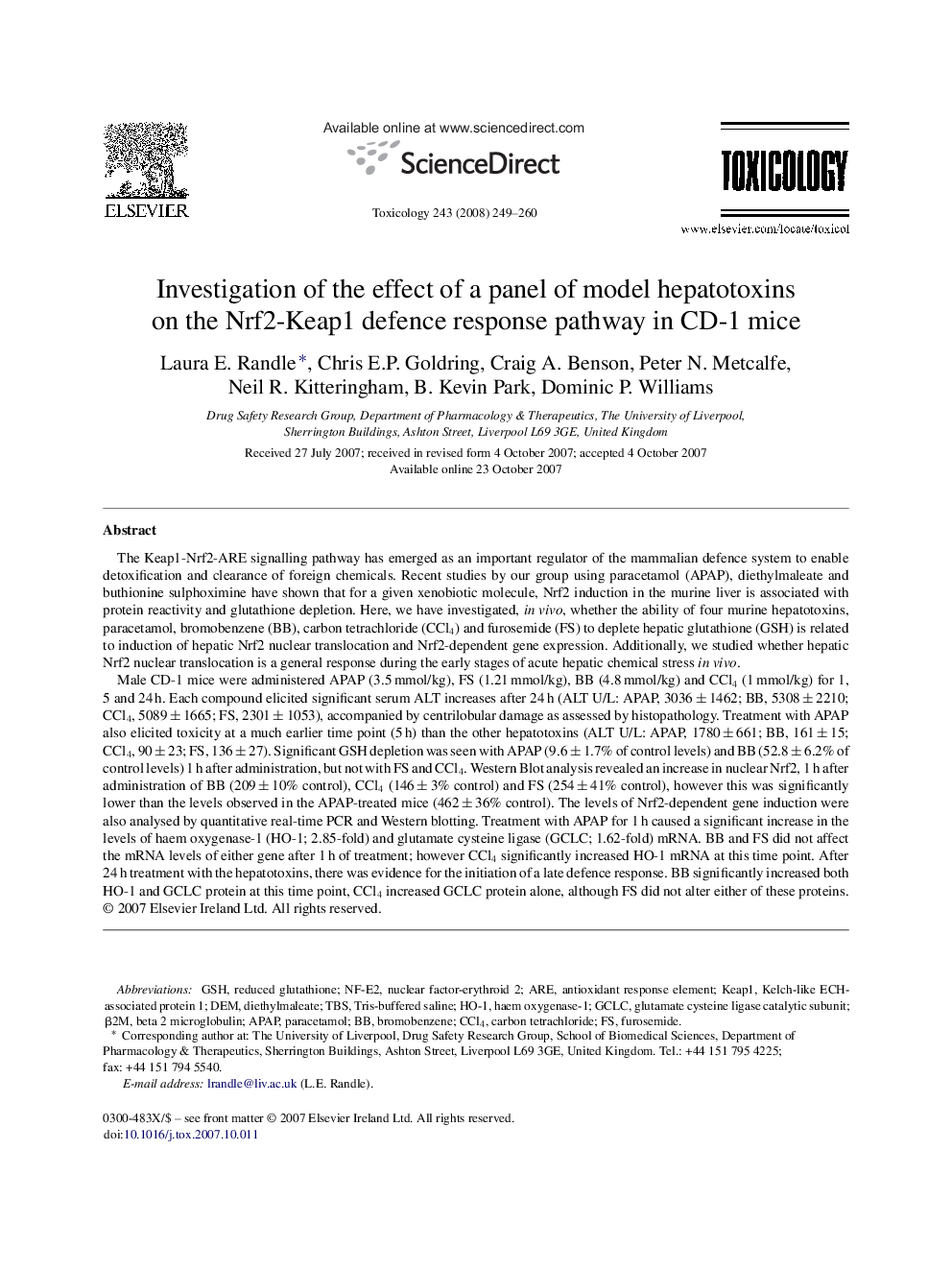| کد مقاله | کد نشریه | سال انتشار | مقاله انگلیسی | نسخه تمام متن |
|---|---|---|---|---|
| 2597327 | 1132576 | 2008 | 12 صفحه PDF | دانلود رایگان |

The Keap1-Nrf2-ARE signalling pathway has emerged as an important regulator of the mammalian defence system to enable detoxification and clearance of foreign chemicals. Recent studies by our group using paracetamol (APAP), diethylmaleate and buthionine sulphoximine have shown that for a given xenobiotic molecule, Nrf2 induction in the murine liver is associated with protein reactivity and glutathione depletion. Here, we have investigated, in vivo, whether the ability of four murine hepatotoxins, paracetamol, bromobenzene (BB), carbon tetrachloride (CCl4) and furosemide (FS) to deplete hepatic glutathione (GSH) is related to induction of hepatic Nrf2 nuclear translocation and Nrf2-dependent gene expression. Additionally, we studied whether hepatic Nrf2 nuclear translocation is a general response during the early stages of acute hepatic chemical stress in vivo.Male CD-1 mice were administered APAP (3.5 mmol/kg), FS (1.21 mmol/kg), BB (4.8 mmol/kg) and CCl4 (1 mmol/kg) for 1, 5 and 24 h. Each compound elicited significant serum ALT increases after 24 h (ALT U/L: APAP, 3036 ± 1462; BB, 5308 ± 2210; CCl4, 5089 ± 1665; FS, 2301 ± 1053), accompanied by centrilobular damage as assessed by histopathology. Treatment with APAP also elicited toxicity at a much earlier time point (5 h) than the other hepatotoxins (ALT U/L: APAP, 1780 ± 661; BB, 161 ± 15; CCl4, 90 ± 23; FS, 136 ± 27). Significant GSH depletion was seen with APAP (9.6 ± 1.7% of control levels) and BB (52.8 ± 6.2% of control levels) 1 h after administration, but not with FS and CCl4. Western Blot analysis revealed an increase in nuclear Nrf2, 1 h after administration of BB (209 ± 10% control), CCl4 (146 ± 3% control) and FS (254 ± 41% control), however this was significantly lower than the levels observed in the APAP-treated mice (462 ± 36% control). The levels of Nrf2-dependent gene induction were also analysed by quantitative real-time PCR and Western blotting. Treatment with APAP for 1 h caused a significant increase in the levels of haem oxygenase-1 (HO-1; 2.85-fold) and glutamate cysteine ligase (GCLC; 1.62-fold) mRNA. BB and FS did not affect the mRNA levels of either gene after 1 h of treatment; however CCl4 significantly increased HO-1 mRNA at this time point. After 24 h treatment with the hepatotoxins, there was evidence for the initiation of a late defence response. BB significantly increased both HO-1 and GCLC protein at this time point, CCl4 increased GCLC protein alone, although FS did not alter either of these proteins.In summary, we have demonstrated that the hepatotoxins BB, CCl4 and FS can induce a small but significant increase in Nrf2 accumulation in hepatic nuclei. However, this was associated with modest changes in hepatic GSH, a delayed development of toxicity and was insufficient to activate an early functional adaptive response to these hepatotoxins.
Journal: Toxicology - Volume 243, Issue 3, 20 January 2008, Pages 249–260